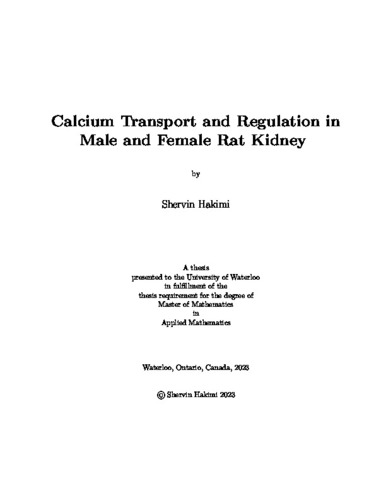UWSpace will be migrating to a new version of its software from July 29th to August 1st. UWSpace will be offline for all UW community members during this time.
Calcium Transport and Regulation in Male and Female Rat Kidney
| dc.contributor.author | Hakimi, Shervin | |
| dc.date.accessioned | 2023-05-16 14:51:30 (GMT) | |
| dc.date.available | 2023-05-16 14:51:30 (GMT) | |
| dc.date.issued | 2023-05-16 | |
| dc.date.submitted | 2023-05-11 | |
| dc.identifier.uri | http://hdl.handle.net/10012/19453 | |
| dc.description.abstract | Calcium is an essential mineral that plays a critical role in many biological processes, such as muscle contraction, nerve function, and bone health. However, maintaining the right balance of calcium in the body is crucial since both high and low levels can have harmful effects. To ensure this balance, the kidney plays a crucial role in regulating calcium homeostasis by reabsorbing calcium in specific segments of the nephron, including the proximal tubule, thick ascending limb, and the late part of the distal convoluted tubule and connecting tubule, and controlling the amount of calcium that is excreted in the urine. This thesis focuses on the computational modelling of renal epithelial calcium handling and sex differences of this process in male and female rat kidneys. Renal epithelial isolated cell models with emphasis on calcium transport are discussed and expanded to a nephron model for both male and female models. Sex differences were observed in the permeability of the proximal tubule to calcium and the expression of calcium channels and pumps in the late part of the distal convoluted tubule and connecting tubule. Our results revealed lower calcium reabsorption along the proximal tubule and thick ascending limb, and higher reabsorption along the late part of the distal convoluted tubule and connecting tubule in the female rat kidney model. Furthermore, the male rat kidney model showed higher urinary calcium excretion compared to the female rat kidney model, consistent with animal experiments. We investigated the effects of perturbations in calcium-specific channels and transporters and sodium-specific transporters on renal calcium handling in male and female rat kidneys. Our findings revealed that inhibiting sodium-specific transporters had a significant impact on renal calcium transport, whereas inhibitions of calcium-specific channels and transporters had minimal effects on sodium transport. We observed that inhibiting Na+/H+ exchanger 3, Na+-K+-2Cl− co-transporter, and Na+-Cl− co-transporter resulted in increased urinary calcium excretion in both male and female models, while epithelial Na+ channel inhibition led to decreased urinary calcium excretion in both male and female models. | en |
| dc.language.iso | en | en |
| dc.publisher | University of Waterloo | en |
| dc.subject | water and solute transport | en |
| dc.subject | mathematical biology | en |
| dc.subject | computational medicine | en |
| dc.subject | computational biology | en |
| dc.subject | fluid dynamics | en |
| dc.subject | applied mathematics | en |
| dc.subject | kidney | en |
| dc.subject | calcium transport | en |
| dc.subject | superficial nephron | en |
| dc.subject | drug discovery | en |
| dc.subject | sex differences | en |
| dc.title | Calcium Transport and Regulation in Male and Female Rat Kidney | en |
| dc.type | Master Thesis | en |
| dc.pending | false | |
| uws-etd.degree.department | Applied Mathematics | en |
| uws-etd.degree.discipline | Applied Mathematics | en |
| uws-etd.degree.grantor | University of Waterloo | en |
| uws-etd.degree | Master of Mathematics | en |
| uws-etd.embargo.terms | 0 | en |
| uws.contributor.advisor | Layton, Anita | |
| uws.contributor.affiliation1 | Faculty of Mathematics | en |
| uws.published.city | Waterloo | en |
| uws.published.country | Canada | en |
| uws.published.province | Ontario | en |
| uws.typeOfResource | Text | en |
| uws.peerReviewStatus | Unreviewed | en |
| uws.scholarLevel | Graduate | en |

